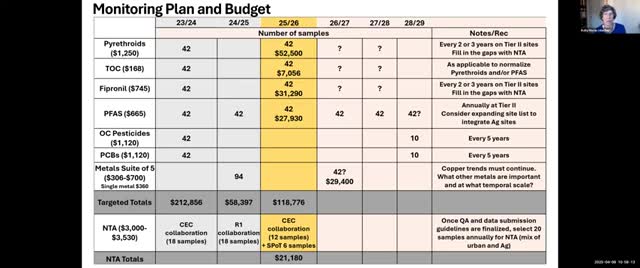USGS shares data on water quality impacts from recreational dog activities
April 26, 2025 | California Water Quality Monitoring Council, Boards and Commissions, Executive, California
This article was created by AI summarizing key points discussed. AI makes mistakes, so for full details and context, please refer to the video of the full meeting. Please report any errors so we can fix them. Report an error »

During the recent California Water Quality Monitoring Council meeting on April 26, 2025, discussions highlighted significant concerns regarding water quality and its implications for public health and environmental management. The meeting focused on the impact of recreational activities, particularly those involving dogs, on water quality in various watersheds.
One of the key topics addressed was the influence of pet-related activities on water contamination. Participants noted that previous issues with chemicals like diazinon and chlorpyrifos had led to sewage treatment plants being out of compliance, particularly when pet owners washed their dogs before visiting water bodies. This anecdotal evidence underscores the need for better understanding and management of how recreational use affects water quality.
Experts from the U.S. Geological Survey (USGS) shared insights on the analysis of watershed contributions from wastewater treatment plants and other variables affecting water quality. They emphasized the importance of utilizing Geographic Information Systems (GIS) to map and analyze these contributions effectively. The discussion pointed out that while the technical aspects of this analysis are manageable, the challenge lies in having the necessary personnel to carry out the work.
Additionally, the meeting touched on the presence of contaminants like piperinell in areas with no urban input, suggesting that recreational activities, such as dogs swimming in ponds or hunting activities in duck clubs, could be contributing factors. This finding raises questions about the sources of contamination and the need for further investigation to protect water quality.
The meeting concluded with a call for collaboration with the Department of Pesticide Regulation (DPR), which has conducted detailed mapping related to these issues. Access to this data could enhance decision-making processes regarding water management and public health.
Overall, the discussions at the meeting highlighted the complex interplay between recreational activities and water quality, emphasizing the need for ongoing research and collaboration to address these challenges effectively. As the community continues to engage in outdoor activities, understanding their impact on water resources will be crucial for ensuring safe and clean water for all.
One of the key topics addressed was the influence of pet-related activities on water contamination. Participants noted that previous issues with chemicals like diazinon and chlorpyrifos had led to sewage treatment plants being out of compliance, particularly when pet owners washed their dogs before visiting water bodies. This anecdotal evidence underscores the need for better understanding and management of how recreational use affects water quality.
Experts from the U.S. Geological Survey (USGS) shared insights on the analysis of watershed contributions from wastewater treatment plants and other variables affecting water quality. They emphasized the importance of utilizing Geographic Information Systems (GIS) to map and analyze these contributions effectively. The discussion pointed out that while the technical aspects of this analysis are manageable, the challenge lies in having the necessary personnel to carry out the work.
Additionally, the meeting touched on the presence of contaminants like piperinell in areas with no urban input, suggesting that recreational activities, such as dogs swimming in ponds or hunting activities in duck clubs, could be contributing factors. This finding raises questions about the sources of contamination and the need for further investigation to protect water quality.
The meeting concluded with a call for collaboration with the Department of Pesticide Regulation (DPR), which has conducted detailed mapping related to these issues. Access to this data could enhance decision-making processes regarding water management and public health.
Overall, the discussions at the meeting highlighted the complex interplay between recreational activities and water quality, emphasizing the need for ongoing research and collaboration to address these challenges effectively. As the community continues to engage in outdoor activities, understanding their impact on water resources will be crucial for ensuring safe and clean water for all.
View full meeting
This article is based on a recent meeting—watch the full video and explore the complete transcript for deeper insights into the discussion.
View full meeting
